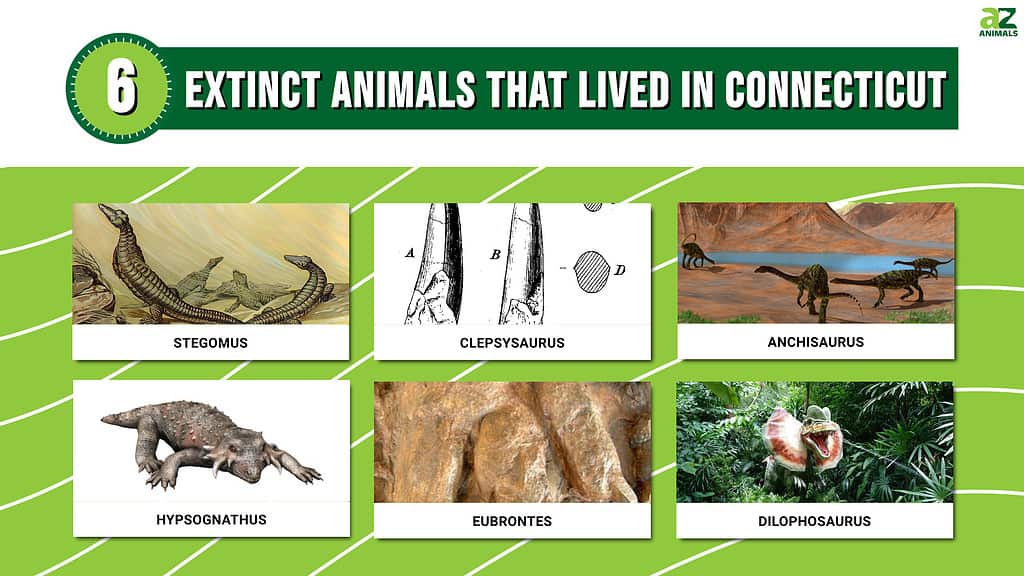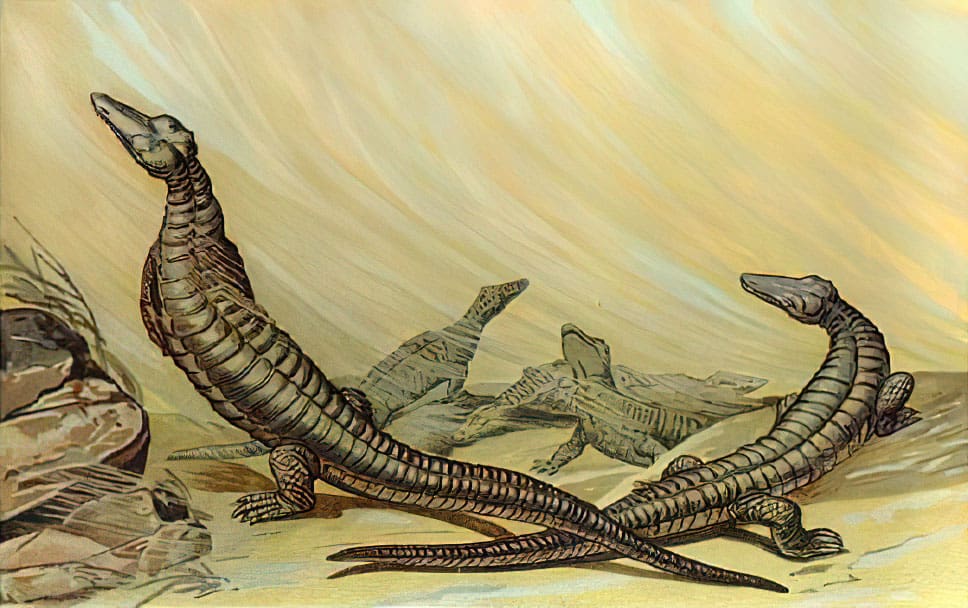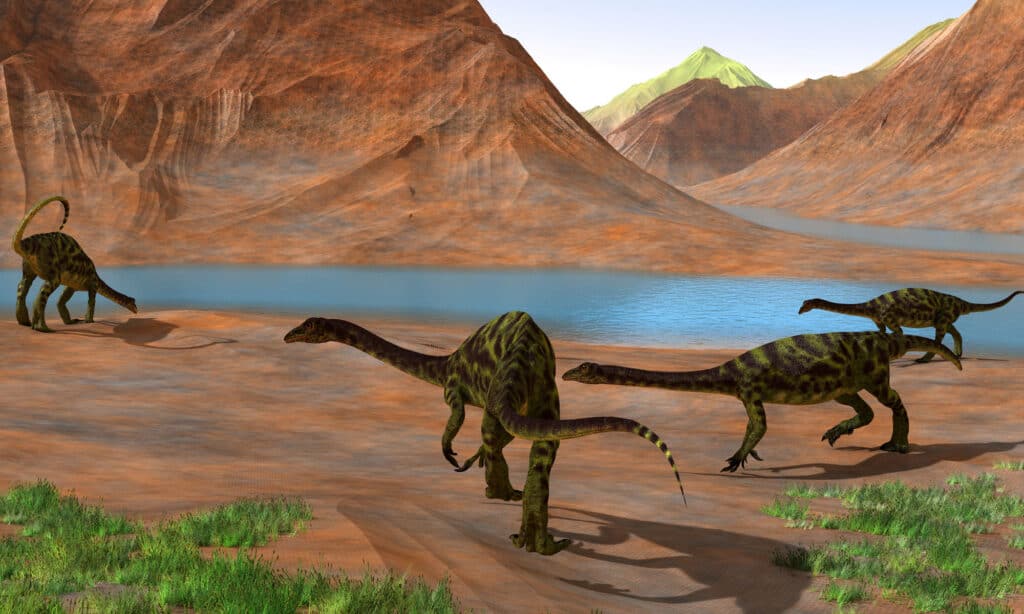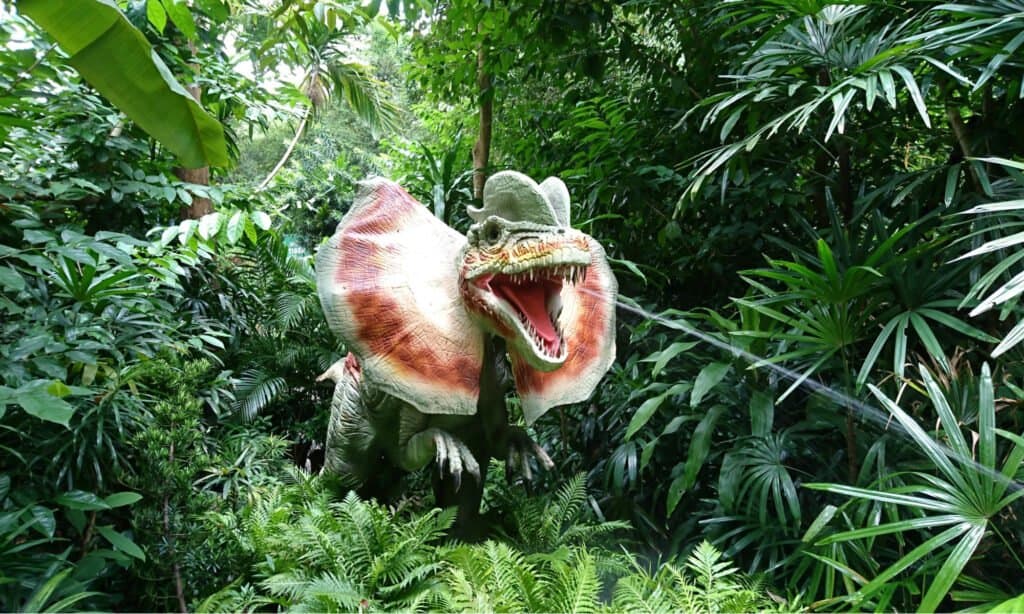The Nutmeg State, also known as Connecticut, is located in the southwestern part of the United States. It is the southernmost state in the New England region. The state is known for being bisected by the Connecticut River.
Humans have lived in the Connecticut area since 10,000 years ago. It’s only natural, given that its area stretches alongside a river. But what about animals and flora? They inhabited this territory from prehistoric times. However, a more important question is: which animals used to live in Connecticut?
To answer the question, this article will help you discover 6 extinct animals that lived in Connecticut!

1. Stegomus (Aetosaurus)

The
Stegomusgenus was synonymized with the
Aetosaurusgenus in 1998.
©F. John / public domain – License
| Stegomus (Aetosaurus) | |
|---|---|
| Kingdom | Animalia |
| Phylum | Chordata |
| Class | Reptilia |
| Clade | Pseudosuchia |
| Order | Aetosauria |
| Family | Stagonolepididae |
| Subfamily | Aetosaurinae |
| Genus | Aetosaurus |
| Extinct since | Norian age of Late Triassic 227-208.5 million years ago |
The Stegomus genus was synonymized with the Aetosaurus genus in 1998. It refers to a pseudosuchian reptile that went extinct during the Norian age of the Late Triassic (227–208.5 million years ago). Pseudosuchia includes living crocodilians and dinosaurs more closely related to crocodilians than birds.
A. arcuatus is the Stegomus species found in eastern North America. Some specimens of Stegomus were also found in the southwestern part of the US. The Stegomus was small and featured a long and narrow carapace. As a defense mechanism, the carapace evolved with spikes.
Stegomus arcuatus was named in 1896. The fossil that made the name possible was found in Connecticut – in the New Haven Formation.
2. Clepsysaurus

Some species of Clepsysaurus have holotypes that are mostly made up of teeth, vertebrae, and ribs.
©Friedrich von Huene / public domain – License
| Clepsysaurus | |
|---|---|
| Kingdom | Animalia |
| Phylum | Chordata |
| Class | Reptilia |
| Clade | Archosauria |
| Genus | Clepsysaurus |
| Extinct since | 201.7 million years ago |
Clepsysaurus is a genus surrounded by mystery, as some would say. It is part of the Archosauria clade and was discovered, in the form of fossils, in the Carnian Passaic Formation in Pennsylvania. Some species of Clepsysaurus have holotypes that are mostly made up of teeth, vertebrae, and ribs, but C. veatleianus only has one tooth.
Not much is known about this genus. Some sources suggest that the Clepsysaurus is part of the Phytosauria group, Palaeosaurus or Anchisaurus. However, it is now seen as a standalone genus.
The Clepsysaurus genus went extinct in the Late Triassic, about 201.7 million years ago.
3. Anchisaurus

Anchisaurus bones were often mistaken for human bones.
©iStock.com/CoreyFord
| Anchisaurus | |
|---|---|
| Kingdom | Animalia |
| Phylum | Chordata |
| Clade | Dinosauria |
| Clade | Saurischia |
| Clade | Sauropodomorpha |
| Clade | Sauropodiformes |
| Clade | Anchisauria |
| Genus | Anchisaurus |
| Species | Anchisaurus polyzelus |
| Extinct since | About 195 million years ago |
Anchisaurus lived during the Early Jurassic Period and went extinct about 195 million years ago. It is a genus of basal (primitive) sauropodomorph (long-necked, herbivorous) dinosaurs. Its name translates to “close lizard” and replaces the initial name given to the genus, Amphisaurus.
The representatives of this genus were about half the size of modern humans. They were only 6.6 ft (2 m) long and weighed around 60 lbs (27 kg). Due to their small size, Anchisaurus bones were often mistaken for human bones. However, according to research, specimens could grow much larger.
Sets of discovered footprints suggest that certain individuals could be up to 20 ft (6 m) long. Anchisaurus were facultative bipeds – their front legs were multi-purpose.
4. Hypsognathus

Hypsognathus is a procolophonid parareptile that lived during the Late Triassic Period.
©Nobu Tamura / CC BY-SA 4.0 – License
| Hypsognathus | |
|---|---|
| Kingdom | Animalia |
| Phylum | Chordata |
| Class | Reptilia |
| Clade | Parareptilia |
| Order | Procolophonomorpha |
| Family | Procolophonidae |
| Subfamily | Leptopleuroninae |
| Genus | Hypsognathus |
| Extinct since | 201.36 million years ago |
Hypsognathus is translated to “high jaw” and is a procolophonid parareptile that lived during the Late Triassic Period. It went extinct about 201.36 million years ago. Fossils of this genus were found exclusively in Nova Scotia, New Jersey, and Connecticut (remains near Meriden).
Procolophonidae is a family of small parareptiles that resemble lizards. On the other hand, parareptiles are a clade of primitive sauropsids.
Hypsognathus was 13 in (33 cm) long, a moderate size. According to research, it is not related to modern lizards. Not much is known about the genus. Fossil analysis suggests that it was a herbivore due to its broad teeth. It also features some sort of protection in the form of spikes on each side of its head. The animal had a low and broad body.
5. Eubrontes

Eubrontes refers to a series of dinosaur footprints that were discovered all over the world.
©Wilson44691 / public domain – License
| Eubrontes | |
|---|---|
| Kingdom | Animalia |
| Phylum | Chordata |
| Clade | Dinosauria |
| Clade | Saurischia |
| Clade | Theropoda |
| Ichnofamily | Eubrontidae |
| Ichnogenus | Eubrontes |
Eubrontes is an interesting entry on this list simply because this name, Eubrontes, doesn’t refer to an extinct animal. Instead, it refers to a series of dinosaur footprints that were discovered all over the world. They are important to the (pre)history of Connecticut because about 95% of the footprints found at Rocky Hill were Eubrontes footprints.
The genus responsible for the footprints is currently unknown. However, research shows that they are similar to the prints of Dilophosaurus or Coelophysis. Later on, it was deemed that the prints were of saurischian origin.
The prints resemble a bird’s foot – three toes that end in sharp claws. Eubrontes was named Connecticut’s state fossil in 1991.
6. Dilophosaurus

The name
dilophosaurustranslates to “
two-crested lizard.”
©Cheng Wei/Shutterstock.com
| Dilophosaurus | |
|---|---|
| Kingdom | Animalia |
| Phylum | Chordata |
| Clade | Dinosauria |
| Clade | Saurischia |
| Clade | Theropoda |
| Genus | Dilophosaurus |
| Species | Dilophosaurus wetherilli |
| Extinct since | 193 million years ago |
The name dilophosaurus translates to “two-crested lizard.” It is a theropod that lived in the territory of North America during the Early Jurassic period. Dilophosaurus went extinct about 193 million years ago.
In terms of size, the genus averages 23 ft (7 m) in length and weighs about 880 lbs (400 kg). Research shows that this dinosaur was the earliest large predatory animal and the largest known land animal in North American territory (during the Early Jurassic period).
The species was discovered in the Kayenta Formation, located across the Colorado Plateau. Dilophosaurus tracks were found in Connecticut. As a result, Dilophosaurus was designated Connecticut’s state dinosaur.
It is worth mentioning that this specific dinosaur was featured in Jurassic Park – both the novel and the movie adaptation. Unlike in the movie, the real-life dilophosaurus couldn’t spit venom and expand its inexistent neck frill.
The photo featured at the top of this post is © iStock.com/CoreyFord
Thank you for reading! Have some feedback for us? Contact the AZ Animals editorial team.






